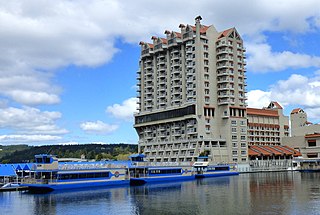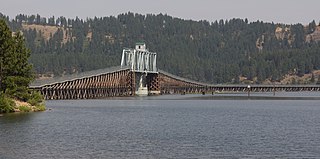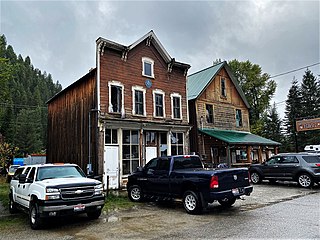
Coeur d'Alene is a city and the county seat of Kootenai County, Idaho, United States. It is the largest city in North Idaho and the principal city of the Coeur d'Alene Metropolitan Statistical Area. At the 2020 census the city's population was 54,628. Coeur d'Alene is a satellite city of Spokane, which is located about thirty miles (50 km) to the west in the state of Washington. The two cities are the key components of the Spokane–Coeur d'Alene Combined Statistical Area, of which Coeur d'Alene is the third-largest city. The city is situated on the north shore of the 25-mile (40 km) long Lake Coeur d'Alene and to the west of the Coeur d'Alene Mountains. Locally, Coeur d'Alene is known as the "Lake City," or simply called by its initials, "CDA."

Wallace, Idaho is a city in and the county seat of Shoshone County, Idaho, in the Silver Valley mining district of the Idaho Panhandle. Founded in 1884, Wallace sits alongside the South Fork of the Coeur d'Alene River, approximately 2,730 feet (830 m) above sea level. The town's population was 784 at the 2010 census.

The Spokane International Railroad was a short line railroad between Spokane, Washington, and the Canadian Pacific Railway (CP) at Kingsgate, British Columbia. The line became an important one for the CP with its connections to the Union Pacific Railroad and Portland, Oregon.
The Silver Valley is a region in the northwest United States, in the Coeur d'Alene Mountains in northern Idaho. It is noted for its mining heritage, dating back to the 1880s.

The Trail of the Coeur d'Alenes is a rail trail in the northwest United States, in northern Idaho. It follows the former Union Pacific Railroad right-of-way from Mullan, a mountain mining town near the Montana border, westward to Plummer, a town on the prairie near the Washington border. Generally following the Coeur d'Alene River, the rail line was abandoned in 1991, and the trail officially opened in March 2004.

The Oregon Railroad and Navigation Company (OR&N) was a railroad that operated a rail network of 1,143 miles (1,839 km) running east from Portland, Oregon, United States, to northeastern Oregon, northeastern Washington, and northern Idaho. It operated from 1896 as a consolidation of several smaller railroads.

Interstate 90 (I-90) is a transcontinental Interstate Highway that runs east–west across the northern United States. Within the state of Idaho, the freeway travels for 74 miles (119 km) from the Washington border near Spokane to Coeur d'Alene and the panhandle region at the north end of the state. After traveling through the Silver Valley along the Coeur d'Alene River in the Bitterroot Range, I-90 crosses into Montana at Lookout Pass.

The history of Spokane, Washington in the northwestern United States developed because Spokane Falls and its surroundings were a gathering place for numerous cultures for thousands of years. The area's indigenous people settled there due to the fertile hunting grounds and abundance of salmon in the Spokane River. The first European to explore the Inland Northwest was Canadian explorer-geographer David Thompson, working as head of the North West Company's Columbia Department. At the nexus of the Little Spokane and the Spokane, Thompson's men built a new fur trading post, which is the first long-term European settlement in Washington state.
The Washington and Idaho Railway was a shortline railroad that operated in the area south of Spokane, Washington, connecting the BNSF Railway at Marshall to Palouse, Washington, Harvard, Idaho, and Moscow, Idaho. It began operations in 2006 on ex-Northern Pacific Railway and Washington, Idaho and Montana Railway trackage formerly operated by the Palouse River and Coulee City Railroad, which had acquired it from the Burlington Northern Railroad in 1996. The railroad ceased operations in 2019 as a new operator gained control of the line.
The following is a brief history of the North American rail system, mainly through major changes to Class I railroads, the largest class by operating revenue.

The Umatilla Central Railroad built a 14.21-mile (22.87 km) branch line of railroad in Umatilla County, Oregon, U.S., connecting the main line of the Oregon Railroad and Navigation Company (OR&N) at Rieth to Pilot Rock. The company was incorporated on May 24, 1906, and was operated under lease by the OR&N from opening date, December 16, 1907, until December 23, 1910, when the properties of both were sold to new Union Pacific Railroad (UP) subsidiary Oregon–Washington Railroad and Navigation Company. The line has survived as UP's Pilot Rock Industrial Lead.
The Snake River Valley Railroad built a rail line on the left (southeast) bank of the Snake River between Wallula and Grange City, Washington, United States, a distance of 65.85 miles (105.98 km). The company was incorporated in Oregon on March 3, 1898, and opened its line, operated by the Oregon Railroad and Navigation Company (OR&N), on December 1, 1899. It connected to the OR&N at both ends, providing a better route to Spokane than the existing line via Walla Walla. The properties of both companies were conveyed to new Union Pacific Railroad (UP) subsidiary Oregon–Washington Railroad and Navigation Company on December 23, 1910.
The Oregon, Washington and Idaho Railroad built a 72.03-mile (115.92 km) rail line along the right (north) bank of the Snake River between Riparia, Washington and Lewiston, Idaho. The company was incorporated in Oregon on August 8, 1903, and began operating its completed line on July 7, 1908, as an operating subsidiary of the Union Pacific Railroad, which also controlled the Oregon Railroad and Navigation Company (OR&N) through Riparia. A portion of the preliminary work had been done by the Snake River Valley Railroad, which built a completed line along the Snake River below Riparia. Beginning on December 3, 1909, the Camas Prairie Railroad, a joint subsidiary of the OR&N and Northern Pacific Railway (NP), began operating the Oregon, Washington and Idaho Railroad as part of a line between Riparia and Grangeville, Idaho, including segments owned by the NP and subsidiary Clearwater Short Line Railway. On December 23, 1910, the property of the Oregon, Washington and Idaho was conveyed to new Union Pacific subsidiary Oregon–Washington Railroad and Navigation Company, successor to the OR&N, but the Camas Prairie Railroad continued to operate it as agent.

The Oregon Eastern Railroad (OERR) is a railroad going from Ontario to Celetom Oregon. The railroad is all that is left of the Wyoming Colorado Railroad which started out as the Malheur Valley Railway. The railroad promotes itself as a "safe, reliable and economical method of transportation" and is proud of the fuel efficiency of railroads.

The Columbia Southern Railway built a rail line extending 69.46 miles (111.79 km) from Biggs south to Shaniko, Oregon, U.S. The company was incorporated on March 5, 1897, and intended to continue beyond Shaniko to Prineville, with a branch to Canyon City. Operations began October 6, 1897, on 8.5 miles (13.7 km) from Biggs to Wasco, and the line was extended to Moro on January 13, 1899, Grass Valley on March 27, 1900, and Shaniko on May 13, 1900. The Union Pacific Railroad (UP), owner of the Oregon Railroad and Navigation Company (OR&N), which followed the Columbia River through Biggs, gained control of the Columbia Southern in 1905, and leased it to the OR&N on June 30, 1906. The properties of the OR&N and Columbia Southern Railway were conveyed to new UP subsidiary Oregon–Washington Railroad and Navigation Company on December 23, 1910.
The Lake Creek and Coeur d'Alene Railroad built a 14.18-mile (22.82 km) rail line between Manito, Washington and Amwaco, Idaho. It was incorporated on July 26, 1906, in Oregon, and completed the line on June 12, 1910. From opening, the company's line, and a steamboat it had acquired, were leased to the Oregon Railroad and Navigation Company (OR&N). The OR&N was already operating a line through Manito to Spokane, and at Amwaco it used the steamboat to cross Lake Coeur d'Alene to Harrison, which was located on another ex-Washington and Idaho Railroad line to Wallace. The combined railroad and steamboat line thus formed a shorter route between Spokane and Wallace than the all-rail route via Tekoa, and helped the OR&N successfully compete with the electric interurban Coeur d'Alene and Spokane Railway and its steamboat connection.

The Columbia River and Oregon Central Railroad built a branch of the Oregon Railroad and Navigation Company (OR&N) from that company's main line at Arlington south to Condon, Oregon, United States. The company was incorporated on August 22, 1903, and finished construction in 1905. A predecessor, Oregon Southern Railway, made surveys and acquired right-of-way, but did not begin construction. Always operated by the OR&N, the property of the Columbia River and Oregon Central Railroad, along with that of the OR&N, was sold to new Union Pacific Railroad (UP) subsidiary Oregon–Washington Railroad and Navigation Company on December 23, 1910. The Condon, Kinzua and Southern Railroad would complete a line from Condon to Kinzua in 1929.

The Oregon Eastern Railway was a predecessor of the Southern Pacific Company that acquired or built most of the Natron Cutoff in northern California and southern Oregon, United States. It also made surveys and acquired right-of-way in eastern Oregon, which were subsequently sold to Union Pacific Railroad subsidiary Oregon–Washington Railroad and Navigation Company.

Murray is an unincorporated community in Shoshone County, Idaho, United States. It is twenty miles from Wallace along Dobson Pass Road. Prichard Creek flows through the community, forming a thin and deep valley in the surrounding Coeur d'Alene Mountains.

Steam navigation on Lake Coeur d'Alene lasted from the 1880s to the 1930s. More steamboats operated on Lake Coeur d’Alene than on any other lake west of the Great Lakes. The high point of steam navigation was probably from 1908 to 1913. After that railroads, and increasingly automobile and truck traffic on newly built highways supplanted steam navigation, although some vessels continued to be operated until the mid-1930s.














